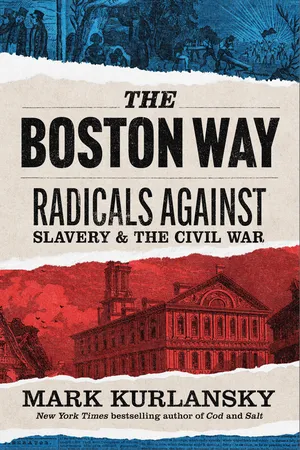
- English
- ePUB (mobile friendly)
- Available on iOS & Android
About this book
“Engrossing”—Wall Street Journal
How do good people find the courage to resist and end the greatest evil in their country? An untold story of the Civil War Era: pacifists in Boston who led the fight to end slavery without violence and war.
Has there ever been good violence or a good war? The American Civil War is likely considered to be so since there seemed to be no alternative. Or was there? Before the war, Bostonian abolitionist William Lloyd Garrison correctly predicted that fighting would not bring about real freedom and justice. If emancipation came about through violence, he believed, it would take at least a century for Black people to get their rights. As we now know, it has taken even longer than that.
Here is the story of Garrison and other abolitionists, Black and white, male and female, who advocated a peaceful end to slavery and the start of human rights for Black people. The Boston Clique, as they were called, were victorious in persuading their fellow Bostonians to end Jim Crow laws on Massachusetts’ railroads. Persuasion was, these pacificists believed, the only means to lasting change.
In these pages, we find Frederick Douglass and lesser-known Black abolitionists, William Nell and Charles Remond. We meet leading feminists of the nineteenth century Lydia Maria Child, Margaret Fuller, Susan B. Anthony, and Elizabeth Cady Stanton. Additional key figures include Adin Balou, William Ladd, and Noah Worcester whose voices for nonviolence impacted Leo Tolstoy, Gandhi, and Dr. Martin Luther King.
Still, if it meant a faster end to the horrors of slavery, wasn’t violence the answer? In time, pacificist abolitionists such as Douglass and John Brown came to believe the entire system in the South needed to be overthrown and that could only happen through the shedding of blood. Time may now provide a different perspective.
While history has little memory of abolitionists, and even less for pacifists, nothing can be learned from that which is not remembered. What if the Civil War had never have been fought? Might we now live in a world of far greater justice and peace? What does this mean today as we still pursue “righteous” violence? This is the story of a road not taken.
Frequently asked questions
- Essential is ideal for learners and professionals who enjoy exploring a wide range of subjects. Access the Essential Library with 800,000+ trusted titles and best-sellers across business, personal growth, and the humanities. Includes unlimited reading time and Standard Read Aloud voice.
- Complete: Perfect for advanced learners and researchers needing full, unrestricted access. Unlock 1.4M+ books across hundreds of subjects, including academic and specialized titles. The Complete Plan also includes advanced features like Premium Read Aloud and Research Assistant.
Please note we cannot support devices running on iOS 13 and Android 7 or earlier. Learn more about using the app.
Information
Table of contents
- Cover
- Title Page
- Copyright
- Dedication
- Epigraph
- Contents
- Prologue: 1859—Pottawatomie Is Back
- One: 1824—Life in Athens
- Two: 1831—Being Heard
- Three: 1833—Here I Am!
- Four: 1835—Sisters in the Clique
- Five: 1837—The Most Difficult Principle
- Six: 1838—A Sweet Solution
- Seven: 1841—Bringing It Home
- Eight: 1843—Kooky Boston
- Nine: 1845—Margaret’s Good Year
- Ten: 1848—A Rope of Sand
- Eleven: 1848—Time for Change
- Twelve: 1850—Fugitives
- Thirteen: 1856—The Practice War
- Fourteen: 1859—The Weird Meteor of War
- Fifteen: 1863—Red Handed Slaughter
- Epilogue: Illusive History
- Acknowledgments
- Bibliography
- Image Sources